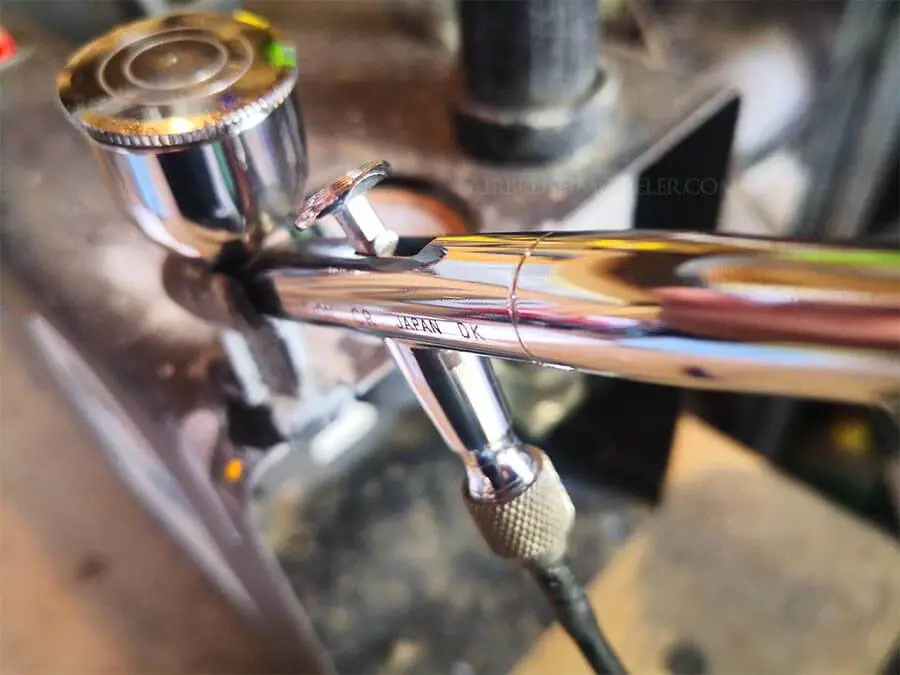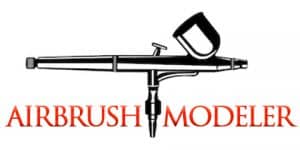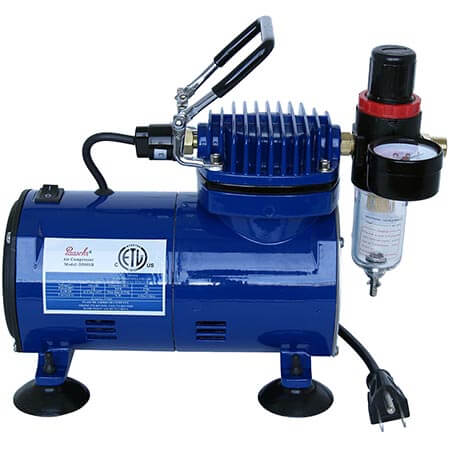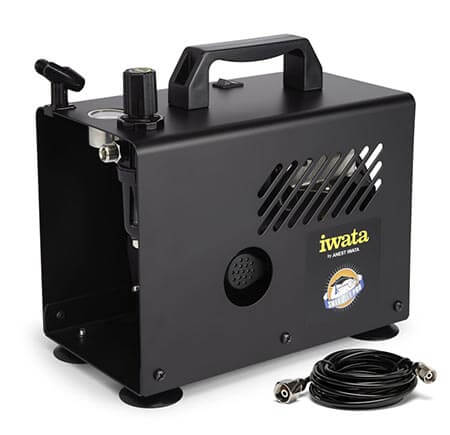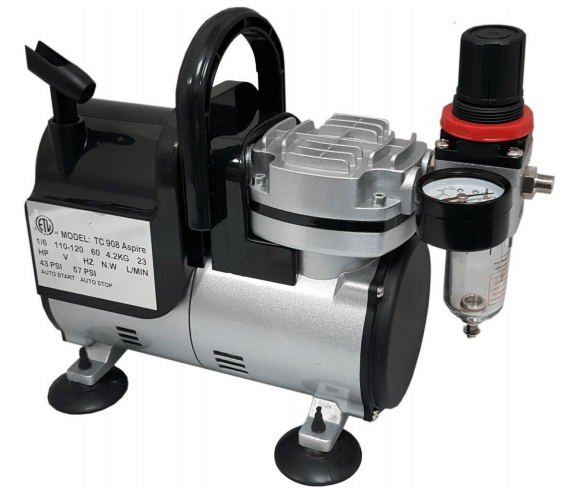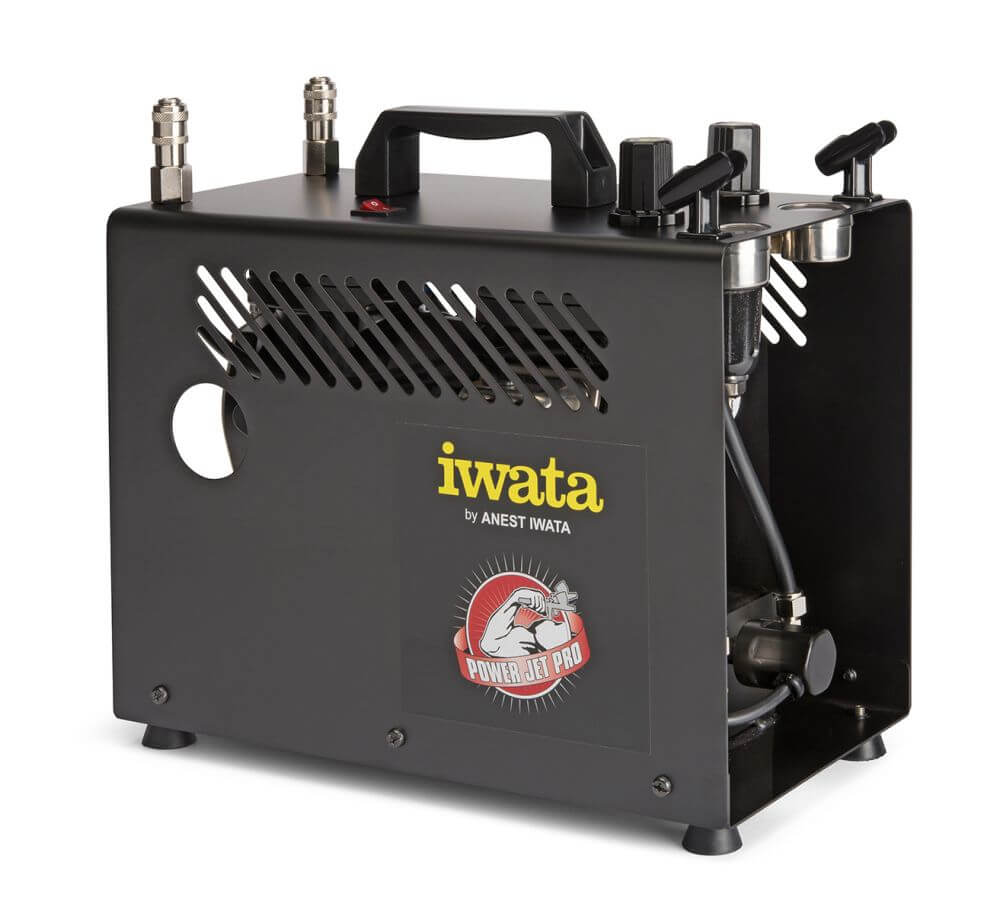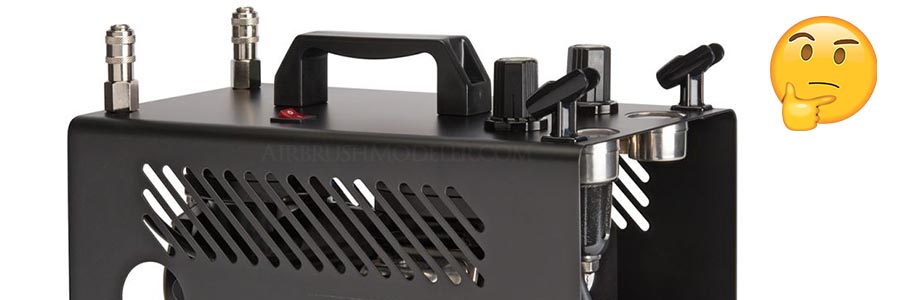
What To Look For When Buying An Airbrush Compressor
When buying a new airbrush compressor you should look for specific features that will make the compressor suitable for the location you’re airbrushing in and the airbrushing job you want to do, as not all airbrush compressors are made equal.
For example, of all the compressors you look at the one you choose to buy will depend on many factors such as noise minimisation, its portability, power and pressure requirements, airbrush connection types and many other variables.
Here’s what we’ll be covering in this article:
- Features Checklist: 👉 a SIXTEEN step checklist of compressor features to learn about and figure out exactly what’s important to you, including example compressors the entire way through;
- Feature Ranking: 👉 ranking those sixteen factors based on your needs;
- Example Ranking: 👉 I’ll show you my own ranking of ‘must-have’ features for my own next compressor purchase;
- Experienced advice: 👉 my (Mark’s) experience with every feature discussed, you’ll get everything you need to know about what to look for and what’s important in a new airbrush compressor; 😎
As you can see it’s not as easy as simply buying on someone else’s recommendation, you really must nail down exactly what you need and see which compressor fits the bill for you perfectly.
So with this in mind I’ve put together a detailed sixteen step checklist that will ensure you’ve pin-pointed the best compressor to buy right off the bat for your own personal needs. 👊
Afterall, an airbrush compressor is an expensive item and you want it not only to last, but to be perfect for your needs for many years and decades to come.
The Exact Features To Look For When Buying An Airbrush Compressor
STEP 1
Compressor Loudness – Are You In A Noise Sensitive Area?
Compressors, even small airbrush compressors, can be reasonably loud, with some performing better than others in this area.
If you live in a noise sensitive area, like a small apartment or a house with a lot of other people, then it may be well worth your while to invest in a compressor that’s on the lower end of the decibel and volume scale.
Having said this, many reputable airbrush compressor companies have gone to lengths to ensure that their compressors are relatively quiet often with some level of sound dampening built in.
As you might expect however, the more powerful the compressor, the louder it will be all other things beings equal.
Let’s look at some example compressors, but first of all we’ll get an idea of various decibel levels for comparison:
| Type Of Noise | Decibel (dBA) Level |
| Pain Begins | 125 |
| Petrol Lawn Mower | 105 |
| Industrial/Workshop Air Compressor | 90 (approx. max.) |
| Average Vacuum Cleaner | 75 |
| Normal Conversation | 65 |
| Whispering | 25 |
Let’s contrast these common noise levels with what you can expect from some of the popular airbrush compressors on the market today that are similar in features with each other:
Compressor Brand & Type | Power (HP) | Noise Level (dBA) | |
Paasche D500SR | 1/5 | 47 | |
For reviews and current prices on the Paasche D500SR see the Amazon listing here | |||
Iawta Smart Jet Pro | 1/8 | 48 | |
For reviews and current prices on the Iwata Smart Jet Pro see the Amazon listing here | |||
Sparmax TC-501N | 1/6 | 48 | |
For reviews and current prices on the Sparmax TC-501N see the Amazon listing here | |||
It should be noted that almost every airbrush compressor brand will have a range of options, with the smaller less powerful units typically being the quieter choices and the more powerful units being louder.
As you can see though, of the options above which are all reasonably comparable when it comes to features, the noise level hovers a little below fifty, which is quite acceptable.
It’s not necessarily ‘quiet’ but it’s certainly not going to be disturbingly loud for neighbours etc.
Contrast this level of noise with a truly grunty airbrush compressor unit, the Paasche DC850R…
Compressor Brand & Type | Power (HP) | Noise Level (dBA) | |
Paasche DC850R | 3/4 | 58 | |
For reviews and current prices on the Paasche DC850R see the Amazon listing here | |||
The above airbrush compressor is about 20% louder (approx. 10db) than the other compressors shown above which have less power.
I’m showing it to help you get some background knowledge on how the volume of these units can change however it’s very unlikely that you’ll ever need a compressor this big and powerful if you’re only using it for building models.
😎 Mark’s Experience & Suggestion on loudness
Realistically you’ll only need a compressor similar to one of the three initially shown, they will be quite powerful enough for model building needs and their noise level is not massively problematic unless you’re airbrushing in very close proximity to other people living nearby (I’m talking insane move-to-a-new-place-asap close).
If you go to a smaller or less powerful unit then you can be fairly confident that you’ll be getting a compressor of equal or less noise level.
At the end of the day, if you can’t find a noise level (decibel) rating for your chosen airbrush compressor you can fall back on the power of the motor with the smaller power generally equating to smaller noise level.
It’s by no means always going to be a perfect measure, but it’s a good general rule of thumb.
Now… for those of you who want even more control over the noise of your compressor, I’ve got another sneaky awesome option for you…
STEP 2
Compressor Auto-Off – Next Level Longevity And Noise Considerations
Airbrush compressor auto-off is a nifty system whereby the compressor senses when you press the trigger on your airbrush and fires up the compressor motor to give you compressed air.
When you take your finger off the trigger the motor stops, simple as that.
This obviously helps with noise as the compressor simply won’t make any noise if it’s not running, so in this way having auto-off on your compressor greatly helps with noise reduction.
Additionally, auto-off will increase the life of your compressor by reducing the wear on the internal parts as it won’t be constantly running while you’re airbrushing.
Let’s take a look at some examples…
Compressor Brand & Type | Auto-Off Feature | |
Iawta Smart Jet Pro | Yes | |
For reviews and current prices on the Iwata Smart Jet Pro see the Amazon listing here | ||
Iwata Ninja Jet | Yes | |
For reviews and current prices on the Iwata Ninja Jet see the Amazon listing here | ||
Now the first example, the Iwata Smart Jet Pro, is the same Iwata brand compressor that was shown in Step 1, and it does come with the auto-off feature.
The second example above from the same manufacturer, the Iwata Ninja Jet, does not have the auto-off feature, however it is still a capable airbrush compressor and worth consideration if you only want to use it for low pressure applications of up to 15psi of ‘working’ pressure (discussed in later steps).
This may be slightly limiting for model building depending on what you’re doing, but sit tight for now and we’ll dive into air pressure requirements a little further down. 👍
Are you missing out on an awful lot if you don’t get the auto-off feature?
Not really, and importantly you’ll still get a lot of longevity and life out of your compressor if you don’t have it, provided you get a trusted brand and don’t go too cheap.
With airbrush compressors you do get what you pay for and you don’t want to skimp too much if you can help it.
😎 Mark’s Experience & Suggestion on auto-off
This is one of those features that shouldn’t make or break a purchase decision, but is rather one of those ‘nice to have’ items.
As mentioned above, it won’t seriously reduce the life of your compressor by not having the feature and you should base your purchase choice on this factor too strongly.
Sure you’ll get some benefits of noise reduction as the unit won’t be actually running nearly as much, so if noise is a huge issue for you then, and only then, would I put more weight on this feature in terms of a purchase decision.
Ultimately, don’t lead with this feature when choosing your airbrush compressor, but rather, if it does appeal to you then let it be one of the deciding factors when you’ve narrowed down your options to two or three. 👍
STEP 3
Overall Compressor Type – Is A Diaphragm Or Piston Compressor More Your Style?
First let’s very quickly go over the two types of airbrush compressor so you can start to get a feel for what will suit you best…
- Diaphragm Airbrush Compressor: a diaphragm air compressor has a pulsating membrane that compresses the air, and will generally give a maximum air pressure of around 50psi or thereabouts, which is easily enough for model painting purposes (usually you will use a lot less). The current model airbrush compressors that were researched for this article did not incorporate an air tank and will run continuously when in use, so the constant noise could be a consideration for you;
- Piston Airbrush Compressor: a piston airbrush compressor will usually have a single or double piston setup that compresses the air, and will allow for higher power and pressure levels than a diaphragm type compressor (although a piston compressor may not necessarily be designed to give higher air pressure);
Because of the more basic nature of the diaphragm air compressors and the lower power and pressure capabilities, they’re often considered beginners compressors.
However, I suggest you not think of them in those terms, rather, simply look at the diaphragm compressor for all of its features and if it fits the bill for you then pull the trigger and make the purchase.
However if you would like the greater capabilities of a piston compressor, higher pressures, ability to use multiple airbrushes, etc, then a piston air compressor would be the way to go.
Let’s check out a couple of examples…
Compressor Brand & Type | Max Air Pressure (psi) | Pressure Regulator | Diaphragm / Piston | |
Paasche D500SR | 35 | Yes | Piston | |
For reviews and current prices on the Paasche D500SR see the Amazon listing here | ||||
Paasche D220R | 50 | Yes | Diaphragm | |
For reviews and current prices on the Paasche D220R see the Amazon listing here | ||||
Paasche DA400R | 50 | Yes | Piston | |
For reviews and current prices on the Paasche DA400R see the Amazon listing here | ||||
Badger Airstorm 180-15 | 57 | Yes | Diaphragm | |
For reviews and current prices on the Badger Airstorm 180-15 see the Amazon listing here | ||||
As you can see the air pressures available are comparable for each type of compressor, however the quality of deliver from each type of compressor can be different, and here’s why…
Pulsating Air Flow 😬
In a diaphragm and single piston compressor, the reciprocating, or compression and decompression, nature of the machine, means that the air pressure will pulse with the compression and decompression cycle.
A dual piston compressor will have the pistons reciprocating alternately so will largely avoid this problem however they are expensive, but, there is a solution to that…
If you choose a diaphragm or single piston airbrush compressor ensure that you get one with a pressure regulator on it, as, amongst other things, it will properly filter out the pulsating in the airflow and give a smooth and constant air pressure to your airbrush.
Truth be told it’s very likely that you will end up with a diaphragm or, more likely, a single piston compressor, as they’re by far the most common and the double piston compressors get pretty expensive and are usually overkill for model painting.
But rest assured that the vast majority of airbrush compressors will come with some form of pressure regulator to alleviate air pressure pulsing.
Just make sure that, when you’ve narrowed things down to your final compressor choice, that it has some kind of pressure regulator or system of alleviating air pressure pulsing.
Perhaps the big win for the diaphragm compressor is price, as the diaphragm style airbrush compressors currently available tend to be on the cheaper side.
😎 Mark’s Experience & Suggestion on overall type
If budget is a concern then the diaphragm airbrush compressor with pressure regulator should be high on your list, but be wary of the amount of noise they make.
While researching a LOT of different compressors for this article I found that the noise levels of diaphragm compressors were, on average, perhaps 10-15% higher than the piston type.
Of course you should check the decibel rating of your shortlisted compressors just in case, but generally speaking it might be worth steering away from the diaphragm type if noise minimisation is an issue for you.
Additionally, you won’t usually find a diaphragm compressor with the auto-off feature that piston compressors have, another reason to opt for piston compressors when you need to be as quiet as possible.
As with the auto-off feature though, the choice of a diaphragm or piston type compressor should not be the leading factor, rather something that generally steers you in one direction or another towards a final choice. 👍
Now, while we’re on the topic of pistons, if you do go down this path you may be presented with another choice of particular piston type…
STEP 4
Compressor Piston Type – Oil-Filled Or Oil-Less, Which Is Better For Airbrushing?
Just as the heading implies, you have the option of oil-filled piston or an oil-less piston.
The oil-filled variety are not common in airbrush compressors.
They’ll be the quieter of the two options by far (think the sound of a fridge motor) and will be able to put out more power, however will require maintenance and lubrication from time to time and will also be the more expensive of the two.
Oil-less pistons on the other hand are noisier than oil-filled but they are by no means ‘loud’.
The big plus to oil-less is that they require zero maintenance and can keep on going for years and years without a hitch.
At the end of the day both types will be absolutely fine for airbrushing models, however the oil-filled is definitely overkill.
Here’s an example of a oil-filled piston type compressor by airbrush manufacturer Harder & Steenbeck…
😎 Mark’s Experience & Suggestion on piston type
The reality is that with the options available today in model and hobby stores you’ll probably never be presented with an oil-filled piston option.
And on the off chance that you are you’ll have to weigh up whether having a quieter and more powerful compressor (power you won’t need if you’re only airbrushing models), against the drawbacks of higher price, less portability is some cases and the need for ongoing maintenance.
Even if I did have a oil-filled option, I can’t personally see any scenario where I’d think it was the better option for me.
STEP 5
Compressor Air Storage – Will A Compressed Air Tank Help Your Airbrushing?
An air storage tank will not improve the quality of your airbrushing… there, I said it 😎
Really we could end this section here, but let’s have a look at what an air tank will do for you on the slim chance that it makes a difference for you personally with your model building or whatever other airbrushing endeavour you have.
The main benefits to have a decent sized air tank incorporated into your compressor are:
- More peace and quiet: if you’re conducting long airbrushing sessions then a compressor with a tank will give you long periods of peace and quiet, as the compressor will fill the tank and then shut itself off. It will only occasionally run momentarily thereafter to refill the tank when required, and you will still retain max air pressure while the motor isn’t running;
- Less moisture: this will be discussed in more detail when we reach the section on moister traps, but generally speaking a larger compressed air tank will give the added benefit of reducing the amount of moisture that flows with the air into the airbrush to mix with the paint. This is a good thing as having water droplets in your paint is usually going to deteriorate the quality of your paint work;
- Possibility of longer life: as the compressor is not constantly running when turned on there will not be as much wear on the parts, potentially giving it longer life. Having said this, the auto-off feature on airbrush compressors without a tank do essentially the same thing so this benefit is not unique to compressors with an air tank installed;
If we touch briefly on the second point above about moisture, I did say at the start of this section that an air storage tank will not help the quality of your airbrushing, which is 99.9% correct.
I also mentioned that we will discuss water traps for removing moisture from the system, and they will take care of the vast amount of water related issues you will have, pretty much entirely negating the need for using an attached air tank to reduce moisture.
Additionally, many airbrush compressors don’t even have a moister trap, much less an air tank, and still provide outstanding airbrushing results, so don’t get too hung up on moisture unless you’re airbrushing in a particularly humid environment.
But for those of you who really want the maximum in noise reduction and moisture control, here are a few excellent airbrush compressor options for you:
Compressor Brand & Type | Max Air Pressure (psi) | Pressure Regulator | Tank Capacity | |
Iwata Power Jet Pro | 75 | YES | 2 Litre | |
For reviews and current prices on the Iwata Power Jet Pro see the Amazon listing here | ||||
Badger Aspire Pro TC910 | 57 | Yes | 3 Litre | |
For reviews and current prices on the Badger Aspire Pro TC910 see the Amazon listing here | ||||
Master Airbrush TC-326T | 57 | Yes | 3 Litre | |
For reviews and current prices on the Master Airbrush TC-326T see the Amazon listing here | ||||
Sparmax TC-620X | 60 | Yes | 2.5 Litre | |
For reviews and current prices on the Sparmax TC-620X see the Amazon listing here | ||||
😎 Mark’s Experience & Suggestion on air tanks
Whether you specifically want an air tank on your compressor really comes down to quietness for extended airbrushing session, the absolute maximum in moisture removal, and the possibility of extended life.
In my experience of having an Iwata Smart Jet Pro compressor with the features of auto-off and a water trap (more details next in Step 6) I’ve never had any problem at all with noise levels or moisture in the paint.
I’ve also had this compressor for going on two decades now, and while it doesn’t look quite brand new anymore it’s still working like a dream and I can’t fault it at all. 👍
For me, using the compressor for building and airbrushing models, I see no reason to upgrade to a more expensive airbrush compressor with an air tank, but…
…that’s me, not you, and you might have a perfectly valid reason to grab a compressor with a tank. 😎
Remember what I said at the start of the article… it’s not for me to tell you what the best compressor is, it’s for me to educate you properly so that you know what the best compressor is for yourself. 👊
STEP 6
Compressor Water Trap – Do You Need That Extra Step Towards Perfection? (or avoiding disaster… 😬)
A compressor water trap, or moisture trap/separator, is a device fitted to a compressor which pulls the moisture out of the air before it is delivered to your airbrush.
The importance of this is that having tiny amounts of water atomised with the paint when it’s being airbrushed will have the ability to potentially ruin an otherwise perfectly good paint job.
For a detailed article on water traps and how they work check out my article on exactly this topic. 👍
Before you tick the “water trap” box on your list of must-have items, let’s not get ahead of ourselves here.
Many airbrush compressors come with no water trap at all, and they’re still perfectly capable of giving excellent results.
It’s unlikely that having a tiny amount of water atomised with your paint will completely ruin your paint job, and especially not with paints that can be thinned with water such as Tamiya and Mr Hobby Aqueous acrylics.
But it may take the lustre out of the paint work when using any paints that can’t be thinned with water, or perhaps leave bubbles of sorts or imperfections that must be sanded and resprayed.
Let’s take a look at some airbrush compressors from a few manufacturers that have water traps, and are what could be considered the closest to their entry level offering…
Compressor Brand & Type | Max Air Pressure (psi) | Noise Level (dBA) | Water Trap | |
Paasche D500SR | 35 | 47 | Yes | |
For reviews and current prices on the Paasche D500SR see the Amazon listing here | ||||
Iawta Sprint Jet | 80 | 50 | Yes | |
For reviews and current prices on the Iwata Sprint Jet see the Amazon listing here | ||||
Sparmax TC-501N | 60 | 48 | Yes | |
For reviews and current prices on the Sparmax TC-501N see the Amazon listing here | ||||
Badger Aspire TC908 | 57 | 62 | Yes | |
For reviews and current prices on the Badger Aspire TC908 see the Amazon listing here | ||||
Before we finalise the discussion on this particular topic though, we must talk about humidity in your airbrushing environment as this can play a big part on whether a water trap is of big benefit.
The higher the humidity, of course, the higher the moisture content in the air, and therefore the more moisture will get sucked into your compressor to be sent directly to your airbrush.
Airbrushing and spray painting in high humidity is a real challenge at the best of times whether you’re using a water trap or not, so if the option is there it’s a good call to get a unit with a water trap if you’ll be experiencing high humidity days fairly often.
😎 Mark’s Experience & Suggestion on water traps
I’ve only ever known compressors with water traps and haven’t used any extensively that didn’t have one.
But, when it eventually comes time to buy a new one (although my current Iwata unit is still bullet proof after almost two decades!) I will likely have the water trap as a must-have feature.
Living in Australia I do tend to get humid stormy days, although I must admit that I’ve also experienced very humid days when we’ve experienced (a rarity) days of drizzle or gentle rain.
I also airbrush in a shed which isn’t as well sealed at a house, so the humidity may infiltrate the space much more easily than inside a house or apartment, just something to consider.
And I know first hand how humidity on its own, even with a water trap installed, can ruin a perfectly good paint job as you can see below on this 1/20 scale Aoshima Nissan Silvia S13.
Final call, I will personally always go with a water trap as I just don’t want to have a build ruined by moisture in the paint as I’ve experienced before, albeit on a rainy day when I probably shouldn’t have been airbrushing.
I can’t justify moving up to a compressor with an air tank, but I’ll certainly take the water trap to pull the vast majority of the moisture out of the air. 👊
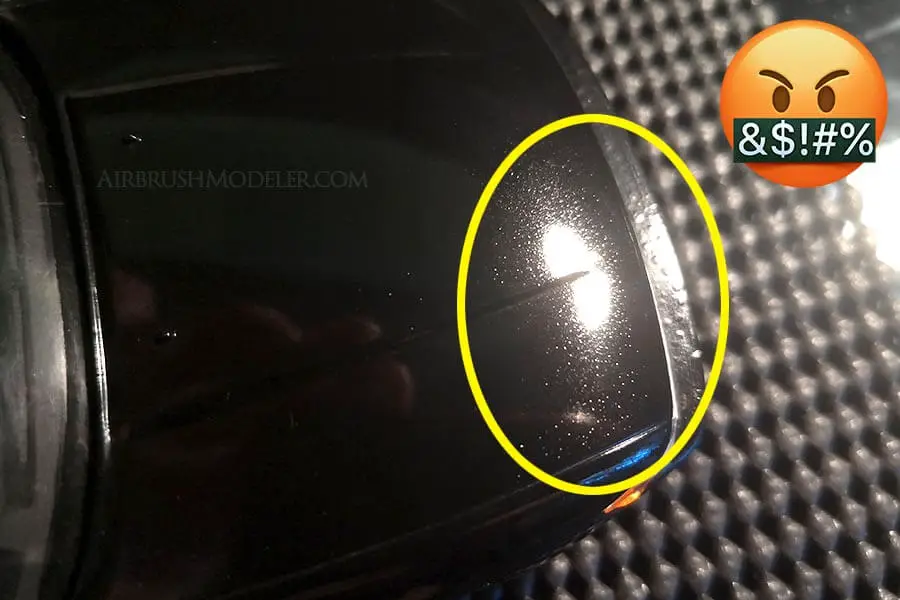
STEP 7
Pressure Gauge/Regulator – Is Controlling The Air Pressure That Beneficial?
A pressure gauge fitted to an airbrush compressor will allow you know the exact air pressure being sent to the airbrush and also confirm that the compressor is functioning correctly.
If your compressor doesn’t have a pressure gauge it will likely have either only one pressure setting, or a few pre-set air pressure settings.
If this is the case then you will get used to each setting with practise and experience on that particular unit, although it could be a bit limiting and result in you needing to thin your paint to match the pressure setting rather than the other way around (which is perhaps more ‘normal’).
Entry level compressors may come with a knob for adjusting air pressure but no accompanying pressure gauge, which makes it difficult to remember what setting worked best for various types of paint, thinning ratios, etc.
Speaking of air pressure regulators, they are a device fitted to you airbrush compressor that allows for extremely precise adjustment of the air pressure being delivered to your airbrush.
This is extremely helpful for when you’re trying to use different paint types or thinning ratios as mentioned briefly above, or when you’re trying to get fine detail work and lines from your airbrush.
Let’s take a look at a couple of entry level airbrush compressors that do and don’t have pressure gauges and regulators…
Compressor Brand & Type | Max Air Pressure (psi) | Noise Level (dBA) | Pressure Gauge & Regulator | |
Paasche D500 | 35 | 47 | No | |
For reviews and current prices on the Paasche D500 see the Amazon listing here | ||||
Paasche D500SR | 35 | 47 | Yes | |
For reviews and current prices on the Paasche D500SR see the Amazon listing here | ||||
Iwata Ninja Jet | 15 | 55 | Gauge No, Regulator Yes (workable but not ideal) | |
For reviews and current prices on the Iwata Ninja Jet see the Amazon listing here | ||||
Iwata Smart Jet Pro | 50 | 48 | Yes | |
For reviews and current prices on the Iwata Smart Jet Pro see the Amazon listing here | ||||
Another thing the eagle-eyed of you might have noticed is that the pressure regulators (the parts with the turn nob on the top) tend to usually have a water trap mounted underneath them.
This is so common that you can assume that if the airbrush compressor has a pressure regulator and gauge then it will have water trap as well (but… double check before you purchase just in case 👍).
Below is an example of a compressor air pressure regulator with accompanying pressure gauge and water trap:
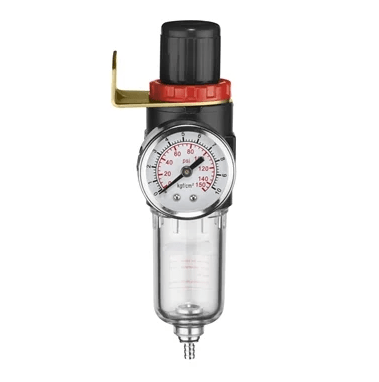
😎 Mark’s Experience & Suggestion on pressure gauges and regulators
All of the compressors I’ve used have had an air pressure regulator and pressure gauge, and I’ve found them invaluable for setting exact pressures for specifically thinned paints of varying types and brands.
Personally I will never purchase a compressor without a fully adjustable pressure regulator and gauge as I will simply lose too much control over the paint types I can confidently use and the thinning ratios I’ll need.
Additionally, the adjusting and fine tuning of air pressure in an airbrush compressor is one of the things that will allow you to do any fine detail and fine lines paintwork that is required.
My recommendation is that you put an air pressure regulator AND gauge high on your list of requirements.
The only two reasons I can see to not go with an airbrush compressor that has a pressure regulator and gauge are:
- Your budget will only stretch to a unit that doesn’t come with a regulator and gauge;
- Or, your only option for getting a compressor with an air regulator and gauge is to drop down to a little-known brand so that it fits within your budget. I would strongly caution you against this as you with these compressors you often get what you pay for, and even the cheap ones are moderately expensive.
STEP 8
Max ‘Working’ Pressure – How Much Air Pressure Do You Really Need For Your Airbrush?
For building models you’ll realistically need an airbrush compressor that can supply up to 30 psi of working air pressure, however you could get away with less, say no less than 20 psi, provided you’re adept at properly thinning your paints and being mindful of the type of paints you’re using
We’ll look at these points and more in detail below, but for future reading if you want my full step-by-step article on how to perfectly thin model paint for airbrushing click this link.
One thing to note at this point is that working pressure is essentially the pressure showing on the gauge (if you have one) when the trigger is fully pressed down on your airbrush.
Be aware that different airbrushes may have different effects on the pressure they allow through, so the working pressure may alter slightly from airbrush to airbrush.
Having said this, consult the manufacturers specifications on the airbrush you think will be the one you want to buy, simply go by the information they give and you can’t go wrong.
Max Working Pressure & Paint Thinning Considerations
The lower the max working pressure, the thinner your paints will have to be, all other things being equal.
This presents a problem when using thicker paints such as some primers or metallic paints, in that they are typically thicker paints and may need significant thinning if your low pressure compressor is to get the paints to atomise through the airbrush properly.
And, as you can imagine, if you over-thin your paints too much they’ll airbrush onto your job far too translucent and will be very prone to running.
However if you have a higher working pressure you can use less thinner and get the thicker paint to atomise and flow properly out of your airbrush and onto your job.
Max working Pressure & Paint Type Considerations
This has been touched on in the last section, however the basics of it are that the higher the working pressure of your compressor the thicker the paints you can use in your airbrush.
If you have a compressor with a low maximum working pressure then you may limited at times in the types of paints you can use, or forced into thinning your model paints more than desired resulting in much more challenging painting conditions.
Max Working Pressure & Cleaning Considerations
You will should be able to spray virtually any model primer and paint with no more than 20 psi of working pressure provided you take the time to thin your paints correctly, however having extra pressure is helpful when cleaning your airbrush as it simply helps to blow to garbage out of the system.
While doing all the normal processes for cleaning, I also like to set my compressor to between 30 and 40 psi and run general purpose thinners through the airbrush with high pressure flowing through at various points throughout the clean to really dislodge any stubborn paint.
Before you go pumping high pressure through your airbrush though, make sure to check the operating manual of your airbrush to ensure it doesn’t have any upper limits on air pressure so that you don’t exceed them and damage something.
By way of example let’s take a look at some Iwata airbrush compressors to see what working pressure range we’re offered before we nail down what direction you should ultimately go…
Compressor Brand & Type | Max Air Pressure (psi) | "WORKING" Air Pressure (psi) | Pressure Gauge & Regulator | Experience Level | |
Iwata Ninja Jet | 40 | 15 | Gauge No, Regulator Yes (workable but not ideal) | Suggested, Entry Level Only | |
For reviews and current prices on the Iwata Ninja Jet see the Amazon listing here | |||||
Iwata Silver Jet | 55 | 18 | Yes | Suggested, Entry Level Only | |
For reviews and current prices on the Iwata Silver Jet see the Amazon listing here | |||||
Iwata Smart Jet | 50 | 30 | Gauge Yes, Regulator No (workable but not ideal) | Suggested, Entry Level Only | |
For reviews and current prices on the Iwata Smart Jet see the Amazon listing here | |||||
Iwata Smart Jet Pro | 50 | 30 | Yes | All Levels | |
For reviews and current prices on the Iwata Smart Jet Pro see the Amazon listing here | |||||
It’s beyond the scope of this article to go through all brands and all models, but from the above table you can see that it pays to look closely at each unit in a brands’ line up to see exactly what features they have relating to air pressure levels and assess what’s suitable for you personally.
And if you can only find the ‘max’ pressure that an airbrush compressor offers, a very very rough (as in, very rough) rule of thumb is to halve the ‘max’ air pressure to get very approximate ‘working’ air pressure.
In all of the tables in this article that reference air pressure make sure you note if the column refers to ‘max’ or ‘working’ pressure, and when looking at a manufacturers information ensure you note which type they’re referring to as well…
…it’s going to extremely unhelpful to get home with your new airbrush compressor and find it’s not giving you the pressure you need because you read the information incorrectly… 😬🤬
😎 Mark’s Experience & Suggestion on max air pressure
As mentioned earlier, I like to have a working pressure of up to 30 psi, but that’s just my preference when it comes to cleaning.
I used to airbrush at those higher pressure settings as well however that was when I was learning and didn’t know how to properly thin my paints and improve my ‘close-in’ airbrushing technique (comes with practise, nothing more).
If my compressor only provided a working pressure of 20 psi it wouldn’t change the quality of my airbrushing paint work.
So for me personally 20 psi or thereabouts is the lowest I would go.
HOWEVER, if I was on a tighter budget I would consider the Iwata Silver Jet with a working pressure of 18 psi, and here’s why…
The difference between 18 and 20 psi isn’t going to make or break any airbrush painting you do, at least for us mere mortals who aren’t airbrushing super heroes…
Plus it has a pressure regulator and a pressure gauge, something that can’t be said for all models of airbrush compressor which sometimes only have one, or none.
Again, for me personally, an air pressure regulator and gauge is perhaps the tip top item on my airbrush compressor requirements list, that’s why I would consider the Iwata Silver Jet if my budget was getting stretched.
So ultimately how important is getting that minimum ~20 psi maximum working air pressure for me…
…as important as having a pressure regulator and gauge, perhaps more so.
I feel that I would be at quite a disadvantage going back to an airbrush compressor without the ability to go to 20 psi, preferably 30 psi, primarily for the reason of being able to use a wider range of paints and having much more scope with thinning ratios.
It’s all about fine tuning and control. 😎
STEP 9
Compressor Motor Power – How Much Grunt Are You Really Going To Need?
Possibly the least important factor when considering which new airbrush compressor to buy, the horse power of a compressor motor is a measure of how much work it can perform.
Simply understand that the power of a compressor motor doesn’t necessarily translate into maximum air pressure delivery in a linear fashion or in the same amounts from compressor to compressor, which makes the ratings for the casual airbrush user somewhat arbitrary.
This is because each different compressor has a slightly different design and engineering incorporated into it all making a different to how the compressor motor applies its power to creating compressed air.
😎 Mark’s Experience & Suggestion on motor power
When looking at airbrush compressors I’m much more concerned about the air pressure it can deliver and what the working pressure it, and I couldn’t care less about the horse power of the unit.
You won’t have option of virtually identical air compressors that have different power ratings, so it’s largely a moot point anyway, and you’ll essentially be stuck with whatever the manufacturer puts on a given compressor that has all the other features you want.
In short, rank it in the bottom three of important things to look when buying a new airbrush compressor. 👍
STEP 10
Compressor Carry Handle – Do You Need Your Compressor To Be Easily Portable?
Some people like the ability to easily cart their compressor around so that they can airbrush at various different locations.
For most this won’t really be a consideration however if you find that, for any reason, being able to airbrush in different locations from time to time would be of benefit to you, compressor manufacturers have put some thought into how you can easily carry your compressor without any fuss.
Let’s take a look at some examples of handle-equipped portable compressors…
Compressor Brand & Type | Noise Level (dBA) | Weight | Handle Equipped | |
Iwata Smart Jet Plus Tubular | Not Listed / TBA | 11.7 lbs / 5.3 kg | Yes | |
For reviews and current prices on the Iwata Smart Jet Plus Tubular see the Amazon listing here | ||||
Badger Aspire Elite TC909 | 47 | 11 lbs / 5.5 kg | Yes | |
For reviews and current prices on the Badger Aspire Elite TC909 see the Amazon listing here | ||||
Paasche D500SR | 47 | 9 lbs / 4.1 kg | Yes | |
For reviews and current prices on the Paasche D500SR see the Amazon listing here | ||||
Sparmax TC-501N | 48 | 7.7 lbs / 3.5 kg | Yes | |
For reviews and current prices on the Sparmax TC-501N see the Amazon listing here | ||||
😎 Mark’s Experience & Suggestion on carry handles
My Iwata Smart Jet Pro does have a carry handle, and while it’s not a necessity for me I have found it handy.
I don’t airbrush anywhere other than at home, however I do move my compressor on and off my work bench occasionally to make room for other work, so having a handle makes it extremely easy to move it around.
It’s not crazy heavy but it’s still much easier to put into tight spaces for temporary storage while I need the workbench space because of the handle.
Ultimately for me, it’s not a make or break feature to have, just a nice convenience, but personally I would rank it very low on the scale of must-have features because at the end of the day it’s not going to do anything at all for the quality of your spray work.
I would recommend you approach it with the same mindset unless you have a valid reason and need to haul your airbrushing setup to different locations. 👍
STEP 11
Size & Weight – Will It Be Stationary, Portable, Or Jammed In A Nook or Cranny?
We’ve already touched on weight to a degree in the last step, but to briefly recap, weight only becomes a consideration if you’re carting your compressor and airbrush setup to different location.
This won’t be common for most people so the weight isn’t something to be concerned about, and even if you do carry your compressor around a lot the most common airbrush compressors that model builders use top out at around 13lb/6kg.
However the size of your compressor perhaps needs a little consideration if you’re pressed for work space.
Perhaps you only have a small nook to place the compressor it, or only a small amount of desk space…
The truth is that the most common and popular airbrush compressors will be similar in their size and footprint, but if space is coming down to the wire for you then the size of the compressor may become a factor.
Here’s a look at some of the more popular compressors bought by model builders and the size and weight of each…
Compressor Brand & Type | Dimensions | Weight | Handle Equipped | |
Iwata Smart Jet Pro | 7.1 x 10.8 x 6.3 (inches) / 18 x 28 x 16 (cm) | 11.9 lbs / 5.4 kg | Yes | |
For reviews and current prices on the Iwata Smart Jet Pro see the Amazon listing here | ||||
Paasche D500SR | 11 x 10 x 6 (inches) / 28 x 25 x 15 (cm) | 9 lbs / 4.1 kg | Yes | |
For reviews and current prices on the Paasche D500SR see the Amazon listing here | ||||
Sparmax Inspire TC-620X | 14 x 13 x 7 (in) / 34.5 x 33 x 18 (cm) | 23 lbs / 10.4 kg | Yes | |
For reviews and current prices on the Sparmax Inspire TC-620X Plus see the Amazon listing here | ||||
The last entry in the table above is probably overkill for scale modelers and is not a common choice amongst us, however it was added to the table so an increased weight comparison could be made between units that have a compressed air tank and those that don’t.
😎 Mark’s Experience & Suggestion on size & weight
The size and weight of an airbrush compressor has never been a point for consideration for me and probably won’t be for most, rather it’ll be a very personal preference driven by a unique situation that you have personally.
That being said, it’s a nice convenience to have when the compressor has a handle, obviously it just makes it easier to move around if and when needed.
Ultimately, unless you know you’ll be moving your compressor around a lot, don’t let the size and weight be a factor in your purchase decision.
STEP 12
Compressor Output Thread/Connection – Will Your Airbrush Even Connect!?
A given brand of airbrush compressor will always be able to connect to the same brands’ airbrushes, however you may run into challenges if not using the same brand equipment.
Some manufacturers realised this and value-added their compressors, such as Iwata with the following information on their Smart Jet Pro compressor:
“…also included are air hose adaptors for Badger, Aztek and Paasche brand airbrushes…”
Or the Paasche D500SR which has a ‘1/4 NPT’ hose fitting as standard but includes in their product information…
“…included with the compressor is a ‘1/8 BPS’ adaptor for competitor hoses…”
If you already have an airbrush and you choose a compressor of the same brand then you’ll be good to go.
However where you end up with different brands of airbrush and compressor ensure the manufacturer specifications show matching fittings or supplied adapters to suit your situation.
😎 Mark’s Experience & Suggestion on output thread/connection
I’ve had experience with both airbrush and compressor setups of the same brand where no adapters were necessary, and also setups using different brands of equipment.
Where I used different brands the compressor I typically used at the time was a full-sized industrial workshop compressor and I used an adaptor to get the airbrush to work perfectly.
Adapters will usually come with the airbrush compressor you buy, at least in the more reputable brands, but none the less do your homework to verify what you do and don’t get, and what adapters are available for your chosen brand of airbrush and compressor if needed, just to be safe. 👍
STEP 13
Multi-Airbrush Capable – Will You Need More Than One Airbrush On The go At Once?
Using multiple airbrushes during the one model painting session is definitely a luxury more than a necessity, and unless you’re a professional model builder it shouldn’t really factor into what to look for when buying a new compressor.
These are two main reasons why you would need a second airbrush connected to the one compressor:
- If you have more than one person airbrushing at the same time; or
- If you have multiple colours or a clear coat that needs to go down in very quick succession;
The first point is very person and situation specific and you’ll know instantly if you fall into this category.
The second point is only likely with technical painting by pro’s, and even then I’m only guessing as I can’t think of a specific situation where I personally would benefit from having a second airbrush with a different colour ready to go instantly.
After all, you still have to load the paint, and you still have to clean each one, so overall time savings isn’t a factor.
Also note that if you’re using a siphon feed airbrush with the bottle hanging underneath, you can very quickly have a premixed colour bottle ready to go for a quick switch after cleaning out the paint tube on the airbrush.
It’s moot if you don’t use a siphon feed airbrush, but it’s something to think about none the less.
But in case multiple airbrushes sounds appealing to you or you find yourself in a situation where having a multi-airbrush-capable compressor would benefit you, have a look below at some of the options for airbrush compressors that are equipped to handle two airbrushes in use at the same time.
Compressor Brand & Type | Noise Level (dBA) | Tank | Multi-Airbrush Capable | |
Iwata Power Jet Pro | 52 | Yes | Yes | |
For reviews and current prices on the Iwata Power Jet Pro see the Amazon listing here | ||||
Badger Aspire Pro TC910 | 47 | Yes | Yes | |
For reviews and current prices on the Badger Aspire Pro TC910 see the Amazon listing here | ||||
Paasche DC850R | 58 | Yes | Yes | |
For reviews and current prices on the Paasche DC850R see the Amazon listing here | ||||
It’s worth noting, in case you didn’t pick up on it, that compressors that can handle multiple airbrushes are usually the larger sized units complete with air tanks, features which won’t give you a better paint job.
😎 Mark’s Experience & Suggestion on multi-airbrush capable
I’ve simply never had a need for more than one airbrush on the go at any one time, and I doubt I ever will.
I expect this will be the same for almost everyone who is only using their compressor and airbrush for building scale models.
So this would likely towards the bottom of required features and won’t be a factor unless you have a very specific and unique situation to you that would benefit by having a second airbrush instantly available.
STEP 14
Airbrush Holder – Do You Have Somewhere To Put Your Airbrush?
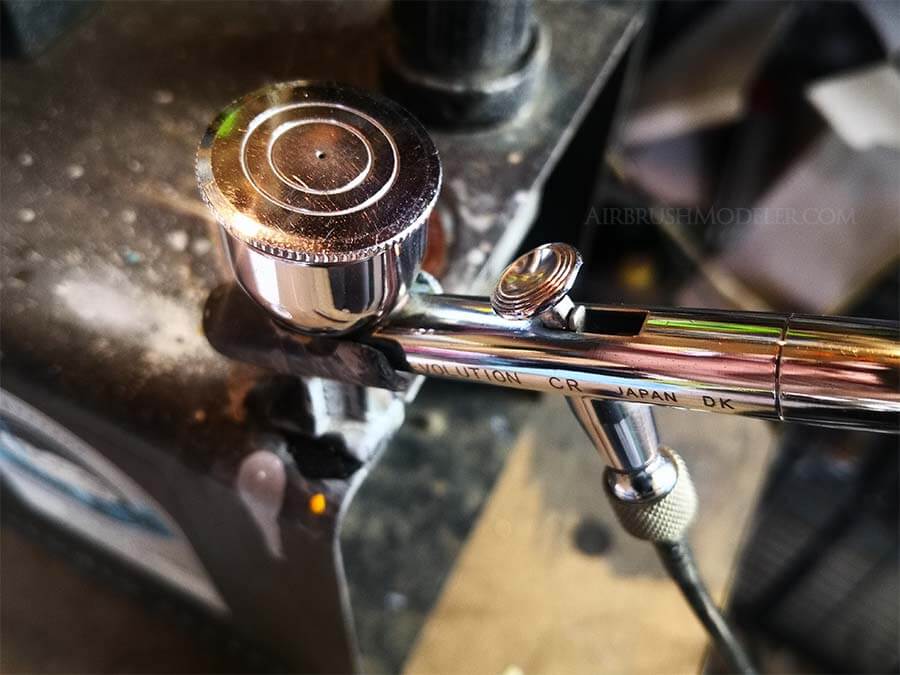
OK, now we’re talking something extremely simple but extremely important!
Especially with a gravity feed airbrush, where are you going to place it when you’re not using it so that it doesn’t fall on its side and the paint spills everywhere…? 🤔
Sure a siphon feed airbrush with the bottle underneath may be able to sit on the flat bottom of the bottle, but a gravity feed is not so simple…
This is where an airbrush holder mounted to your compressor comes in extremely handy, BUT…
…they don’t all ship with holders. 🙄
Let’s take a look at some common airbrush compressors that would appear quite similar but for whatever reason do, or don’t, ship with an airbrush holder…
Compressor Brand & Type | Pressure Gauge & Regulator | Airbrush Holder | |
Iwata Silver Jet | Yes | Yes | |
For reviews and current prices on the Iwata Ninja Jet see the Amazon listing here | |||
Iwata Sprint Jet | Yes (gauge only) | No | |
For reviews and current prices on the Iwata Sprint Jet see the Amazon listing here | |||
Iwata Smart Jet Pro | Yes | Yes | |
For reviews and current prices on the Iwata Smart Jet Pro see the Amazon listing here | |||
Paasche D500SR | Yes | No | |
For reviews and current prices on the Paasche D500SR see the Amazon listing here | |||
Badger Aspire TC908 | Yes | Yes | |
For reviews and current prices on the Badger Aspire TC908 see the Amazon listing here | |||
If the compressor you have your eye on doesn’t have an airbrush holder however, don’t despair, you can easily obtain aftermarket airbrush holders.
Check out these easily-to-get and extremely affordable options below…
Compressor Brand & Type | Noise Level (dBA) | |
Iwata Universal Airbrush Holder | ALL: | |
For reviews and current prices on the Iwata Universal Airbrush Holder see the Amazon listing here | ||
Master Airbrush Universal Clamp Holder | ALL: | |
For reviews and current prices on the Master Airbrush Universal Clamp Holder see the Amazon listing here | ||
😎 Mark’s Experience & Suggestion on airbrush holders
Where I’ve used a siphon feed airbrush before, with the bottle hanging underneath, I’ve always sat the airbrush on the flat bottom of the bottle, I didn’t have an airbrush holder at the time.
This was using a Badger branded airbrush and it was weighted such that this was possible, however I cannot confirm that this will be the case with all brands of siphon feed airbrush.
My dedicated airbrush compressor however, the Iwata Smart Jet Pro, does come with an airbrush holder so when I upgraded to my Iwata Revolution CR gravity feed airbrush it had somewhere to be placed right off the bat.
In short, you’re going to need somewhere to safely place your airbrush so that it’s not in any danger at all of being knocked over, so one way or another I would strongly urge you to get an airbrush holder, whether incorporated into your compressor or aftermarket.
Given aftermarket airbrush holders are so easy and relatively cheap to get, this particular feature has no need of being high on the list of requirements.
STEP 15
Compressor Brand – Do You Really Get What You Pay For?
With regards to airbrushes and airbrush compressors, as with virtually everything, you do get what you pay for.
Compressors are basic technology for the most part so the engineering of them may not be super advanced as such, however the quality of the components will come into play in terms of the longevity of your compressor.
If you go cheap, you can rest assured you’ll be getting lower quality parts which are more prone to failing in shorter time frames.
Throughout this article I’ve limited my examples to four reputable brands, being Iwata, Badger, Paasche and Sparmax.
You can confidently buy these brands knowing that you’ll be getting a high quality product that may not last quite a full lifetime, but should come very close if they do fall short.
This is not to say that there aren’t other brands out there that are excellent choices, but rather than me pointless listing endless brands and models, I’ve instead taught you what you need to know to decide on the best compressor for you, and you can apply that knowledge to any compressor you’re presented with. 👊
😎 Mark’s Experience & Suggestion on brands
I bought my Iwata Smart Jet Pro sixteen years ago and while it’s a little worse for wear, it’s still going very strong, I simply cannot fault it and it would be a strong contender for when I eventually need to get a new one.
Having said that though I will also look at other known and reputable brands out there when the time comes to get a new unit.
How high does brand sit on the list of must-have features…
…I would say to stick with the main brands that you see discussed commonly online (like the ones mentioned in this article) but outside of that keep the brand fairly low on the scale of must-have features.
Given how long they’ve been in the game, all of the top brands will be of excellent quality. 👍
STEP 16
Compressor Price – What Does Your Budget Allow For?
😎 Mark’s Experience & Suggestion on price
The reality is that consideration of features on any given airbrush compressor becomes irrelevant if that compressor is out of your price range.
So essentially what it comes down to is getting the most feature rich compressor where those features match your airbrushing and compressor requirements, that your allotted budget of money can buy.
However, here is what I would put to you…
An airbrush compressor from a reputable brand is going to be with your for a significant amount of time, so it will also be best if you can buy what you’ll need in say five to ten years when your skills are much improved, because your compressor will likely last that long.
I assure you that you will most likely outgrow a compressor with no pressure regulator and gauge before long, and while you can get aftermarket regulators and gauges it’s not always the most ideal solution to the problem of not having one, nor is it going to be cheap.
For this reason I would urge you get the most feature rich unit you can even if it does cost you a little more, however…
…I’m not saying to blow all your money and savings on it.
What I’m saying is that it’s worth your while to wait a little longer, save up some more money, and get the compressor that truly works perfectly for your needs.
So, with all of that being said, let’s do a recap on all of the features (but leaving out price as a factor for now) and we’ll look at an example of what my personal must-have features list would be, and what compressors I would shortlist for myself…
Let’s do it!
THE FUN BIT… 😀
Ranking Your Must-Have Features When Buying An Airbrush Compressor
So we have sixteen features overall, although we’ll pare that back to fifteen by not being concerned with price at this stage, it will come last.
What’s required of you now is to consider everything you’ve just learned about the benefits of each feature and rank all of them, don’t leave any out.
What this will do, as you can probably guess, is give you your shopping list of must-haves for when you’re selecting an airbrush compressor.
I’ve done this process below for my own compressor feature requirements and then noted down some of the compressors that are shortlisted based on my ranked feature list…
Rank | Compressor Feature | Reason |
1 | Brand | Only buy from well-known reputable brands. No other features really matter if you buy cheap crap that breaks quickly. |
2 | Max. Working Pressure | At least 30 psi working air pressure. |
3 | Pressure Gauge / Regulator | I'm so used to using one and enjoying the advantages of fine tuning air pressure, there no going back now! |
4 | Water Trap | Better safe than sorry, I've seen first hadn what moisture in the paint does to the finished job. |
5 | Auto-Off | Pretty much mandatory for noise minimalising, like everything else above. |
6 | Piston Type | Oil-FREE, I don't need the hassle of maintenance nor the additional cost. |
7 | Airbrush Holder | Oil-FREE, I don't need the hassle of maintenance now the additional cost. |
8 | Loudness | As quiet as possible, but with auto-off I'm less concerend if the compressor itself is a litle louder than usual. |
9 | Output Connection | Not a huge issue if I have to get an adaptor, but it's just massively convenient if it's good to go out of the box. |
10 | Carry Handle | Nice to have, don't care much if I don't have it though. |
11 | Overall Type | Piston, not diaphragm. No real reason, it's just what I've owned in teh past and I'm happy with it. |
12 | Air Storage Tank | Not required. |
13 | Size & Weight | Don't care, I know airbrush compressors aren't crazy heavy so I'm good however much it weighs. |
14 | Multi-Airbrush Capable | Nope, don't care. |
15 | Motor Power | Care factor nil. |
😎 Mark’s Verdict…
It’s been an interesting exercise going through the features list and ranking them and I enjoyed it a lot more than I was expecting!
I must admit that I swapped a few of them around a lot, but ultimately they quite easily fit into three different categories as you can probably tell with the colour coding.
BLUE
The first six features written in blue are non-negotiable ‘must-have’s‘. If I can’t find a compressor that has all of those features then I don’t buy a new compressor, it’s that simple.
In my opinion they’re just too expensive to settle for something that’s not spot on.
BLACK
The features written in black are my ‘really want but can live without’ features, and I’m somewhat flexible with them and open to change or settling to get the very best of the ‘must have’ features. 👍
RED
The red features… nope, just don’t care about any of these features or considerations, and if they happen to come with the compressor I buy then that’s just a bonus.
What Are MY Top 4 Best Airbrush Compressors For 2020 😎
These are the airbrush compressors available that I’ve narrowed down to given my list of must-have features.
You’ll find one compressor from each of the four airbrush compressor brands discussed in this article, being the one that was best for me out of their current range, and some information on why I chose it.
And remember, the heading on this section was a middle-finger parody of sorts towards the garbage articles out there trying to give you ‘top ten’ lists that aren’t helpful… I’m not trying to tell you what is best for you even if your features list mirrored mine closely.
I’m teaching how to know for yourself which is the best compressor for you, but that being said…
…let’s take a look at what I’ve shortlisted which in no particular order… 👇
Compressor Brand & Type | Reasons For This Choice | |
Iwata Smart Jet Pro | Yes | |
For reviews and current prices on the Iwata Smart Jet Pro see the Amazon listing here | ||
Passche D500SR | Yes (gauge only) | |
For reviews and current prices on the Paasche D500SR see the Amazon listing here | ||
Badger Aspire Elite TC909 | Yes | |
For reviews and current prices on the Badger Aspire Elite TC909 see the Amazon listing here | ||
Sparmax TC-501N | Yes | |
For reviews and current prices on the Sparmax TC-501N see the Amazon listing here | ||
So that’s my own personal shortlist of four compressors that I would then research further regarding the following:
- Compare each compressor against the other too see if any of the must-have features are better than others, for example, one compressor may have a higher ‘max working pressure’ than all the others, which would give it a slight edge all other things being equal;
- Compare each compressor to see if any of them had additional ‘really want’ features (shaded blue in the table) that others did not;
- Consider the overall price, as there are some bargains to be had from time to time. If I’ve narrowed it down to two very comparable compressors that are say $100 apart in price that’s going to get my attention;
Take your time with this process and enjoy it, after all it’s in investment in your creativity and happiness to take your through the coming decade and more! 👍
OK, NOW IT’S YOUR TURN!
GO, GO, GO…!
Final Thoughts On Finding The Best Airbrush Compressor For Model Building
If you’ve made it this far you’ve waded through almost ten thousand words of awesome compressor content 😎👊 and you’ll be very well educated on knowing what to look for when buying a new airbrush compressor.
As mentioned earlier you should lead with figuring out your must-have features giving due consideration what you’ll need in the coming decade and how your skills will improve over that time, as a good quality airbrush compressor from a reputable brand can certainly last you that long without missing a beat.
I would urge you to figure out your must-have features first and then shortlist some compressors that meet your requirements, and only then check the prices.
If the shortlisted compressors are in your price range, pull the trigger and make the purchase with confidence!
If you’re still a little short on the money side of things then I’d recommend to just wait it out until you save up a little more and get what you really need and want, so that it serves you absolutely perfectly for years and even decades to come, just like mine has…
